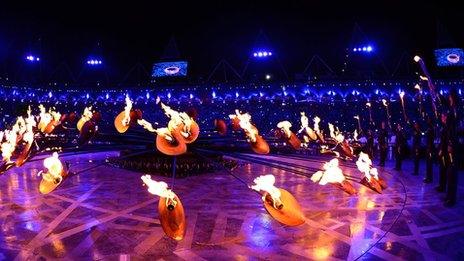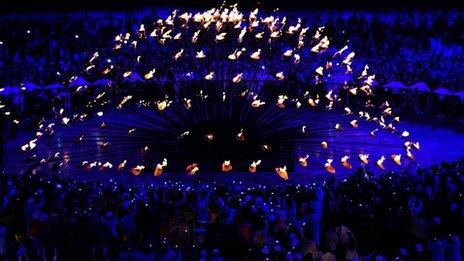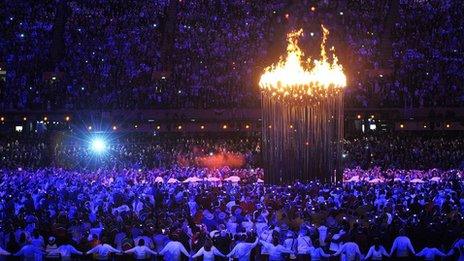Olympic cauldron represents peace says designer Heatherwick
- Published
Designer Thomas Heatherwick has said his Olympic cauldron represents the "coming together in peace" of each of the 204 competing countries.
His creation, which provided a dazzling finale for Friday's opening ceremony, was unlike any other Olympic cauldron.
It was made up of 204 flames in copper petal-like bowls mounted on stems which, once lit by seven young torchbearers, were raised to merge into one huge flame.
Heatherwick said at the end of the Games, each nation would be given its petal to take away and the cauldron would "dismantle itself" and disappear.
"We were aware that cauldrons have been getting bigger, higher and fatter as each Olympics has happened and we felt that we shouldn't try to be even bigger than the last ones," he said.
"We were thinking about this incredible event with these 204 nations coming together, a peace somehow, even though [it is part of] a sporting challenge.

The 204 petals were lit and then raised into the air
"It didn't feel enough to just design a different shape of bowl on a stick, and so we were trying to think from the most fundamental where - as much as how - as much what, and working with Danny [Boyle] on who would make this happen."
He said that the concept of having no cauldron, "the stadium having no 'thing' in it", was how he approached the design.
He was aiming for "these 204 very small, humble objects where they come together and rise, rear out of the surface of centre the stadium".
When the first of 10 rings had risen into place, the last one was lifting and coming together.
"So it was like a dandelion seed being blown - but it seemed to work, which was a huge relief," he said.
The copper petals, made at Harrogate-based firm StageOne, were created by traditionally skilled craftsmen of the sort who used to roll sheet metal to make body parts for car makers such as Bentley, according to Heatherwick.
"It is like the biggest gadget that anyone can make in a shed but this shed is the most sophisticated shed in Harrogate.

Thomas Heatherwick said the raised petals were "like a dandelion seed being blown"
"It was like the Bond gadget workshop."
The designer, who has been described as "the Leonardo da Vinci" of our times by Sir Terence Conran, added that at the end of the Games "the idea is that this cauldron will dismantle itself and come back to the ground".
"These pieces will be taken away by the NOC [National Olympic Committee for each country].
"They will be these heated elements, maybe they will get buffed, but everyone will have a piece."
Australian firm FCT Flames, which specialises in the design, manufacture and operation of flame effects for ceremonial events, was responsible for creating the gas burners in the petals.
Their managing director, Constantino Manias, said the cauldron was "quite different to anything that we've worked with before" in that "it's actually created out of almost nothing".

The individual flames all joined to form one large flame
He said the challenge for them was to make the 204 flames "as low-key as possible", which meant that the equipment for each flame had to be as small as possible, including electrical wiring, the gas supply and a flame detector.
When the flames came together, "it didn't look at all like a cauldron," he said, adding the it was key that all the flames merged "into a single flame - that was quite, quite important".
Much of his company's preparation time for the cauldron was spent researching what sort of burner and what sort of flame shape was needed, and how the air flow around this would occur to produce the effect that was wanted by the artist".
Research was followed by development, then engineering and test work. Then the equipment was designed, manufactured and finally delivered to the stadium.
The flames themselves are "beautiful things, they're live things but they're also dangerous things", he said, adding they involve control equipment, valve trains, burners and ignition systems.
"So one of the prime considerations is safety," he added.
"We do a number of modelling exercises to determine how hot things will get, we need to make sure that the heat doesn't affect anything that causes damage or harm to people. So that's certainly a challenge."